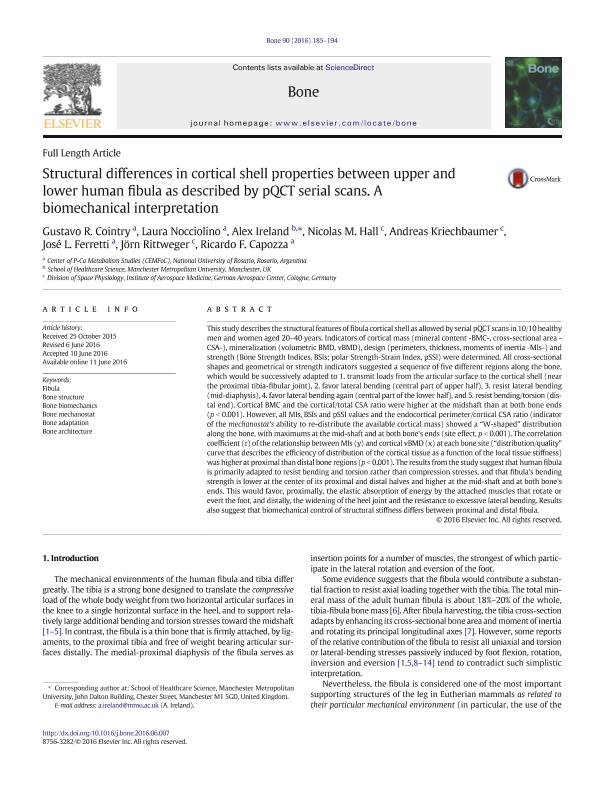Mostrar el registro sencillo del ítem
dc.contributor.author
Cointry, Gustavo Roberto

dc.contributor.author
Nocciolino, Laura Marcela

dc.contributor.author
Ireland, Alex

dc.contributor.author
Hall, Nicolas M.
dc.contributor.author
Kriechbaumer, Andreas
dc.contributor.author
Ferretti, Jose Luis

dc.contributor.author
Rittweger, Jörn
dc.contributor.author
Capozza, Ricardo Francisco

dc.date.available
2018-07-20T19:33:30Z
dc.date.issued
2016-09
dc.identifier.citation
Cointry, Gustavo Roberto; Nocciolino, Laura Marcela; Ireland, Alex; Hall, Nicolas M.; Kriechbaumer, Andreas; et al.; Structural differences in cortical shell properties between upper and lower human fibula as described by pQCT serial scans. A biomechanical interpretation; Elsevier Science Inc; Bone; 90; 9-2016; 185-194
dc.identifier.issn
8756-3282
dc.identifier.uri
http://hdl.handle.net/11336/52774
dc.description.abstract
This study describes the structural features of fibula cortical shell as allowed by serial pQCT scans in 10/10 healthy men and women aged 20–40 years. Indicators of cortical mass (mineral content -BMC-, cross-sectional area -CSA-), mineralization (volumetric BMD, vBMD), design (perimeters, thickness, moments of inertia -MIs-) and strength (Bone Strength Indices, BSIs; polar Strength-Strain Index, pSSI) were determined. All cross-sectional shapes and geometrical or strength indicators suggested a sequence of five different regions along the bone, which would be successively adapted to 1. transmit loads from the articular surface to the cortical shell (near the proximal tibia-fibular joint), 2. favor lateral bending (central part of upper half), 3. resist lateral bending (mid-diaphysis), 4. favor lateral bending again (central part of the lower half), and 5. resist bending/torsion (distal end). Cortical BMC and the cortical/total CSA ratio were higher at the midshaft than at both bone ends (p < 0.001). However, all MIs, BSIs and pSSI values and the endocortical perimeter/cortical CSA ratio (indicator of the mechanostat's ability to re-distribute the available cortical mass) showed a “W-shaped” distribution along the bone, with maximums at the mid-shaft and at both bone's ends (site effect, p < 0.001). The correlation coefficient (r) of the relationship between MIs (y) and cortical vBMD (x) at each bone site (“distribution/quality” curve that describes the efficiency of distribution of the cortical tissue as a function of the local tissue stiffness) was higher at proximal than distal bone regions (p < 0.001). The results from the study suggest that human fibula is primarily adapted to resist bending and torsion rather than compression stresses, and that fibula's bending strength is lower at the center of its proximal and distal halves and higher at the mid-shaft and at both bone's ends. This would favor, proximally, the elastic absorption of energy by the attached muscles that rotate or evert the foot, and distally, the widening of the heel joint and the resistance to excessive lateral bending. Results also suggest that biomechanical control of structural stiffness differs between proximal and distal fibula.
dc.format
application/pdf
dc.language.iso
eng
dc.publisher
Elsevier Science Inc

dc.rights
info:eu-repo/semantics/openAccess
dc.rights.uri
https://creativecommons.org/licenses/by-nc-sa/2.5/ar/
dc.subject
Bone Adaptation
dc.subject
Bone Architecture
dc.subject
Bone Biomechanics
dc.subject
Bone Mechanostat
dc.subject
Bone Structure
dc.subject
Fibula
dc.subject.classification
Anatomía y Morfología

dc.subject.classification
Medicina Básica

dc.subject.classification
CIENCIAS MÉDICAS Y DE LA SALUD

dc.title
Structural differences in cortical shell properties between upper and lower human fibula as described by pQCT serial scans. A biomechanical interpretation
dc.type
info:eu-repo/semantics/article
dc.type
info:ar-repo/semantics/artículo
dc.type
info:eu-repo/semantics/publishedVersion
dc.date.updated
2018-07-18T20:50:29Z
dc.journal.volume
90
dc.journal.pagination
185-194
dc.journal.pais
Estados Unidos

dc.description.fil
Fil: Cointry, Gustavo Roberto. Consejo Nacional de Investigaciones Científicas y Técnicas. Centro Científico Tecnológico Conicet - Rosario; Argentina. Universidad Nacional de Rosario. Facultad de Ciencias Médicas. Centro de Estudios de Metabolismo Fosfocálcico; Argentina
dc.description.fil
Fil: Nocciolino, Laura Marcela. Consejo Nacional de Investigaciones Científicas y Técnicas. Centro Científico Tecnológico Conicet - Rosario; Argentina. Universidad Nacional de Rosario. Facultad de Ciencias Médicas. Centro de Estudios de Metabolismo Fosfocálcico; Argentina
dc.description.fil
Fil: Ireland, Alex. University of Manchester; Reino Unido
dc.description.fil
Fil: Hall, Nicolas M.. German Aerospace Center; Alemania
dc.description.fil
Fil: Kriechbaumer, Andreas. German Aerospace Center; Alemania
dc.description.fil
Fil: Ferretti, Jose Luis. Consejo Nacional de Investigaciones Científicas y Técnicas. Centro Científico Tecnológico Conicet - Rosario; Argentina. Universidad Nacional de Rosario. Facultad de Ciencias Médicas. Centro de Estudios de Metabolismo Fosfocálcico; Argentina
dc.description.fil
Fil: Rittweger, Jörn. German Aerospace Center; Alemania
dc.description.fil
Fil: Capozza, Ricardo Francisco. Consejo Nacional de Investigaciones Científicas y Técnicas. Centro Científico Tecnológico Conicet - Rosario; Argentina. Universidad Nacional de Rosario. Facultad de Ciencias Médicas. Centro de Estudios de Metabolismo Fosfocálcico; Argentina
dc.journal.title
Bone

dc.relation.alternativeid
info:eu-repo/semantics/altIdentifier/url/https://www.sciencedirect.com/science/article/pii/S8756328216301594
dc.relation.alternativeid
info:eu-repo/semantics/altIdentifier/doi/https://doi.org/10.1016/j.bone.2016.06.007
Archivos asociados
